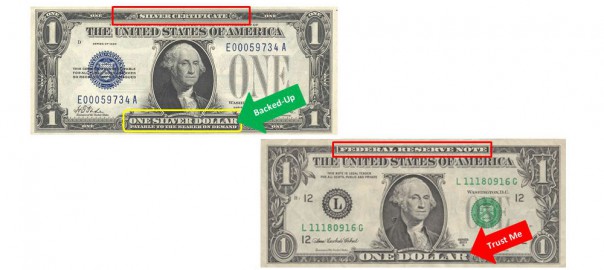What is money? It seems like a very straight forward and simple question. Yet, when the question is posed, most people seem to have trouble describing exactly what it is and the function it is supposed to serve. Most think of money in terms payment for work, goods, or services either provided or received. But, can you describe its characteristics, what it represents and the role it plays in the economy? What is the difference between “legal tender” (currency) and “specie”, and can “legal tender” and “specie” be the same thing? Can you? Most to whom I ask these questions cannot.
A good exercise is to take a dollar from your wallet, and ask them to read the “President” side of the “dollar”. The very top says “Federal Reserve Note”. A good question to ask is, “What is a note?” The answer being that a “note” is a financial debt instrument. On the left hand side of the dollar is the Seal of the United Stated Federal Reserve, and under the seal it states, “This Note is Legal Tender For All Debts, Public and Private”. The “Note” is legal tender, as it falls under the legal tender laws. We are compelled to use it. At this point, I would ask, “Does this ‘money‘ have any counter party risk? In other words, if I hold a note, I am a creditor, so there must be a debtor, —— because someone owes me a dollar’s worth of something. For every creditor, there must be a debtor, thus, —— there is “counter party risk”. The counter party risk in this case is that these “notes” can be printed (or digitally created) into oblivion, thereby, making them worthless. Creditors holding these “notes” are at the mercy of the party issuing these notes. What we have are bank notes operating as currency, a medium of exchange.
In contrast, at this time,—— there is a coin that qualifies as “legal tender”, and is sold by the United States Mint. “The American Silver Eagle is uniquely the only legal tender silver dollar bullion coin whose one troy ounce weight, 99.9% fine silver content, and purity is guaranteed by the United States Government.” (Source: http://www.ebay.com/gds/SILVER-DOLLAR-HISTORY-/10000000012391709/g.html) The American Silver Eagle has a face value of $1.00, but requires approximately $20.00 worth of Federal Reserve Notes to purchase. Why the disparity? Both face values have been set at $1.00, yet —— the bullion will buy considerably more than the Federal Reserve note.
While the value of the American Silver Eagle can vary, it is “money” in the western classical sense that has withstood the test of history. Aristotle said that money had to have 5 characteristics: 1) it has to have intrinsic value —— value in many uses; 2) it has to be convenient —— portable, able to transport; 3) it has to be divisible —— for denominating in multiple values; 4) it must be durable —— not easily created or destroyed; and 5) it must be consistent —— of consistent value in weight and measure. Because the American Silver Eagle is commodity based, and fulfills Aristotle’s criteria, it is not subject to the same counter party risk of bank notes. There is no counter party risk. Coin in circulation has been referred to as “specie” throughout history. Any derivative of coin, like a “silver certificate“, —— which was redeemable in coin in the United States, is also considered to be specie. The Silver Certificates used by the United States up to 1964 looked almost identical to today’s Federal Reserve Note, —— only the header says “Silver Certificate”.
What does the Constitution have to say about money? Article I, Section 8-5, gives Congress alone the authority “To coin Money, regulate the Value thereof, and of Foreign Coin, and fix the standard of Weights and Measures”. “It is worth noting that the term “coin” would appear to disallow the printing of paper money, or at least of paper not fully redeemable in gold and silver coin.” (Source: http://www.thenewamerican.com/culture/history/item/4791-americas-inflation-and-hyperinflation) Article I, Section 10-1. — “No State shall enter into any Treaty, Alliance, or Confederation; grant Letters of Marque and Reprisal; coin Money; emit bills of Credit; make any Thing but gold and silver Coin a Tender in Payment of Debts; pass any Bill of Attainder, ex post facto Law, or Law impairing the Obligation of Contracts, or grant any title of Nobility.
Why did the Founding Fathers see fit to include this in the Constitution? The century prior to, and through the Revolutionary War was ripe with the creation of bank notes, inflation, and hyperinflation in the Colonies. The Massachusetts Bay Colony was the first to introduce paper money to the New World. The colony would conduct periodic raids on French Canada and pay the soldiers in plunder. In the early 1600s when one of the raids did not go well, the colony elected to print 7000 pounds of paper notes to pay the soldiers, redeemable in two years in silver or gold collected from the citizenry via taxation. The Massachusetts Bay colonial government also promised not to print anymore notes. But the government’s promise was short lived, as it could not resist the power of modern day alchemy, the printing press. Citizens eventually resisted the government script, and legal tender laws were instituted to force its usage. The other Colonies followed suit. The wholesale creation of bank notes eventually caused problems with trade forcing England to initiate the Currency Act of 1751, followed by the Currency Act of 1764. Both prohibited the use, of what came to be called, “bills of credit” in private transactions. England’s attempt to rein in the wholesale printing insanity was actually viewed as subversive to the affairs of the American Colonies. The Revolutionary War gave the colonies license to print even more fiat (paper notes), as they were emancipated from the restrictions of England’s Currency Acts. It was a race to the bottom, an expression we hear more today, —— as nations ease monetary policy through zero interest rates (even negative) and quantitative easing (printing money) in order to devalue their currencies making their exports more attractive. The bottomline, —— by the time of the Constitutional Convention of 1787, Americans had had enough of paper money, inflation, and hyperinflation. (Much of the information in this paragraph is from a very thorough article on this subject in the October 2010 The New American magazine. Link: http://www.thenewamerican.com/culture/history/item/4791-americas-inflation-and-hyperinflation)
So, where does the United States stand today on the issue of “money”. Laurence J. Kotikoff, a Professor of Economics at Boston University, using CBO (Congressional Budget Office) figures estimates that the U.S. national indebtedness is $222 trillion dollars, and growing. That is $17 plus trillion current, national debt, plus over $200 trillion in unfunded liabilities for Social Security, Medicaid and other entitlement programs. When trying to get someone to understand the magnitude of a trillion dollars, I point out that a trillion seconds, —— is 32,000 years! The numbers are mind numbing. I ask myself, “How long will our foreign nations continue to buy our debt to finance something as unsustainable as this?” Again, they carry the “counter party risk” of the U.S. defaulting either through inflation of the currency, or outright default.
The following are examples of the ravages of fiat currencies since the founding of our country.
- 1921 Poland, food prices double every 19 days.
- 1923 Germany, they double every four days.
- 1944 Greece, they double every four days.
- 1946 Hungary, food prices double every 15 hours.
- 1982 Mexico, the inflation rate hit 10,000%, driving the price of food up 100 times in 12 months.
- 1989 Argentina, the Peso was devalued three times, driving food prices up 3,079% in a single year.
- 1994 Brazil, inflation raged at 2,075.8% per year, making food more than 20 times more expensive.
- 1994 Yugoslavia, food prices double every 34 hours.
- 2008 Zimbabwe, food prices double every single day.
(Source: Koinonia Institute – Personal Update – May 2015 – Link to: http://www.khouse.org/personal_update.new/pdfs/personal_update_1505.pdf)
There is more than one school of economics. The United Sates began with a bi-metal standard as money. Congress was charged with coining, regulating its value and foreign currencies, and setting the standard for weights and measures. Through the Federal Reserve Act of 1913, the failure of Bretton Woods, closing of the gold window by Nixon in 1971, and the rise of the petrodollar in 1973, —— the United states has drifted to the Keynesian School of Economics, —— one that promotes fiat currency, deficit spending, and central planning and control of the monetary system. It is a debt based system, and our currency is proof of it.
I will leave you with this thought about what money is, and what it should not be. Money should be a representation of our ability to create, work, and labor, —— a safe and secure store of value to be used as a medium of exchange, —— solving the problem of what economists call “the incidence of coincidence”. It should be a fungible proxy of our labor, to be used at our convenience, for the purchase of goods and services we need and desire. What it should not be is a debt instrument, with counter party risk, insecure, and able to be destroyed at the whim of unrestrained central bankers and planners. Not to be printed or digitally created by fiat, destroying price discovery, reasonable measures of value, —— and eventually undermining confidence in a currency.
Proverbs 20:23 – “Divers weights are an abomination unto the Lord, and a false balance is not good.”



